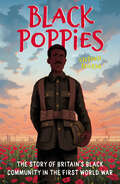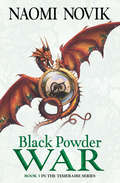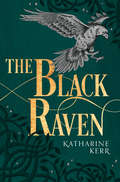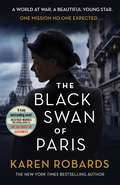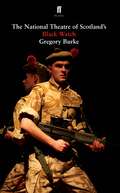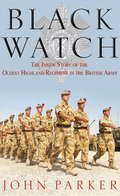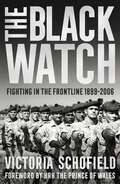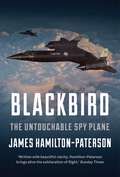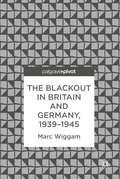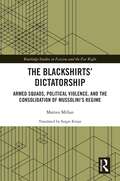- Table View
- List View
Black Poppies: Britain's Black Community And The Great War
by Stephen BourneDid you know that Black people from around the world helped Britain fight in the First World War?How heroic were the people who fought?Why did Black people have to keep fighting for equality even after the war?In this young readers’ edition of Black Poppies, Stephen Bourne takes us on a hero-filled journey. Explore the many and extraordinary ways in which Black people helped Britain fight the First World War, on the battlefield and at home. After meeting Stephen’s Aunty Esther, we hear the story of Walter Tull, who led soldiers in some of history’s bloodiest battles and died in the fighting just weeks before the conflict would end. Then there is Alhaji Grunshi, an African who fired the first shot of the whole war. Back at home, Black men and women helped by entertaining the people, making materials like bullets and uniforms, and beginning the long fight for equality and the freedom to celebrate being Black and British with pride.
Black Powder War: Temeraire, Throne Of Jade, Black Powder War (The Temeraire Series #3)
by Naomi NovikNaomi Novik’s stunning series of novels follow the global adventures of Captain William Laurence and his fighting dragon Temeraire as they are thrown together to fight for Britain during the turbulent time of the Napoleonic Wars.
The Black Raven (The Dragon Mage #2)
by Katharine KerrBook ten of the celebrated Deverry series, an epic fantasy rooted in Celtic mythology that intricately interweaves human and elven history over several hundred years.
Black Shame: African Soldiers in Europe, 1914-1922
by Dick van Galen Last Ralf Futselaar Marjolijn De JagerBlack Shame offers a detailed analysis of the recruitment and deployment of – and reactions to – African soldiers in the WWI European theatre of war. In so doing, the book paints a vivid picture of the wider debates of race and national identity provoked by the use of African troops within the main actors on the WWI scene: France, Britain, Germany and even the US. Drawing on war-time attitudes, Dick van Galen Last explores the reality and long-term consequences of the participation of African regiments in the post-war occupation of the German territories. Wide-ranging, both geographically and thematically, the first publication of its kind, Black Shame adds a fresh, truly comparative perspective to the scholarship in the fields of imperial and military history, as well as war studies and postcolonial studies, and will appeal to academics and postgraduate students alike.
Black Shame: African Soldiers in Europe, 1914-1922
by Dick van Galen LastBlack Shame offers a detailed analysis of the recruitment and deployment of – and reactions to – African soldiers in the WWI European theatre of war. In so doing, the book paints a vivid picture of the wider debates of race and national identity provoked by the use of African troops within the main actors on the WWI scene: France, Britain, Germany and even the US. Drawing on war-time attitudes, Dick van Galen Last explores the reality and long-term consequences of the participation of African regiments in the post-war occupation of the German territories. Wide-ranging, both geographically and thematically, the first publication of its kind, Black Shame adds a fresh, truly comparative perspective to the scholarship in the fields of imperial and military history, as well as war studies and postcolonial studies, and will appeal to academics and postgraduate students alike.
Black Soldiers, White Wars: Black Warriors from Antiquity to the Present
by William E. Alt Betty L. AltThis overview explores the use of black people, either through coercion or enticement, in the armed forces of predominantly white societies in times of crisis when the supply of white soldiers was exhausted or when whites refused to fill the ranks of a wartime army. A chronological review, the study begins with references to Biblical armies and ends with the technological environment of the modern world, looking at how blacks were employed, exploited or rewarded for their service over the centuries. While the balance sheet is mixed, military institutions have proven to be leaders in integration and equality for blacks both in the United States and in Europe. Inequality still exists in the modern American military; however, the authors contend, it is more likely to be based upon educational disparities than on the color of a soldier's skin.African American soldiers played a significant role in the creation and expansion of the United States. The authors write about conquistadors who utilized blacks as soldier slaves. They recount the stories of the black men who fought during the Revolutionary War. They detail the experience of the Buffalo Soldiers in securing and protecting the western wilderness and follow the black soldier fighting alongside Teddy Roosevelt's Rough Riders. From the decks of the battleship ^IMaine^R to the Philippine Islands, from the hills of Vietnam and the deserts of the Middle East, and, finally, to the all-volunteer army, this book reveals the impact that black soldiers have made on American history.
Black Spartacus: The Epic Life of Toussaint Louverture
by Sudhir HazareesinghThe definitive modern biography of the great slave leader, military genius and revolutionary hero Toussaint LouvertureThe Haitian Revolution began in the French Caribbean colony of Saint-Domingue with a slave revolt in August 1791, and culminated a dozen years later in the proclamation of the world's first independent black state. After the abolition of slavery in 1793, Toussaint Louverture, himself a former slave, became the leader of the colony's black population, the commander of its republican army and eventually its governor. During the course of his extraordinary life he confronted some of the dominant forces of his age - slavery, settler colonialism, imperialism and racial hierarchy. Treacherously seized by Napoleon's invading army in 1802, this charismatic figure ended his days, in Wordsworth's phrase, 'the most unhappy man of men', imprisoned in a fortress in France.Black Spartacus draws on a wealth of archival material, much of it overlooked by previous biographers, to follow every step of Louverture's singular journey, from his triumphs against French, Spanish and British troops to his skilful regional diplomacy, his Machiavellian dealings with successive French colonial administrators and his bold promulgation of an autonomous Constitution. Sudhir Hazareesingh shows that Louverture developed his unique vision and leadership not solely in response to imported Enlightenment ideals and revolutionary events in Europe and the Americas, but through a hybrid heritage of fraternal slave organisations, Caribbean mysticism and African political traditions. Above all, Hazareesingh retrieves Louverture's rousing voice and force of personality, making this the most engaging, as well as the most complete, biography to date.After his death in the French fortress, Louverture became a figure of legend, a beacon for slaves across the Atlantic and for generations of European republicans and progressive figures in the Americas. He inspired the anti-slavery campaigner Frederick Douglass, the most eminent nineteenth-century African-American; his emancipatory struggle was hailed by those who defied imperial and colonial rule well into the twentieth. In the modern era, his life informed the French poet Aimé Césaire's seminal idea of négritude and has been celebrated in a remarkable range of plays, songs, novels and statues. Here, in all its drama, is the epic story of the world's first black superhero.
The Black Sun (Tom Kirk Ser. #2)
by James TwiningHigh adventure, mind–blowing suspense. Tom Kirk, the world’s greatest art thief, is back on another life–threatening mission. Now available in e-book format for the first time.
The Black Swan of Paris: The heart-breaking, gripping historical thriller for fans of Heather Morris
by Karen RobardsA world at war. A beautiful young star. A mission no one expected.'A truly outstanding novel, brilliantly written, that captured me and held me in its grip from page one. The Black Swan of Paris reminds us of the power of love, hope and courage'Heather Morris, #1 bestselling author of The Tattooist of AuschwitzParis, 1944Celebrated singer Genevieve Dumont is both a star and a smokescreen. An unwilling darling of the Nazis, her position of privilege allows her to go undetected as an ally to the resistance.When her estranged mother, Lillian de Rocheford, is captured by Nazis, Genevieve is shaken. She knows it won't be long before the Gestapo succeeds in torturing information out of Lillian that will derail the upcoming allied invasion. The resistance movement is tasked with silencing her by any means necessary - including assassination.But Genevieve refuses to let her mother become yet one more victim of the war. Reuniting with her long-lost sister, she must find a way to navigate the perilous cross-currents of Occupied France undetected - and in time to save Lillian's life.For fans of Danielle Steele's The Spy, Jane Thynne's Black Roses and Heather Morris' The Tattooist of Auschwitz, this exquisite novel illuminates three women's strength, courage and capacity for unconditional love.PRAISE FOR THE BLACK SWAN OF PARIS'Emotional and powerful'Pam Jenoff, bestselling author of The Lost Girls of Paris'Beautifully written and completely absorbing. 'Noelle Salazar, bestselling author of The Flight Girls'An extraordinarily suspenseful, emotional read'Kelly Rimmer, bestselling author of The Things We Cannot Say'A truly outstanding novel, brilliantly written, that captured me and held me in its grip from page one. The Black Swan of Paris reminds us of the power of love, hope and courage'Heather Morris, #1 bestselling author of The Tattooist of Auschwitz
Black Tommies: British Soldiers of African Descent in the First World War
by Ray CostelloBlack Tommies is the first book entirely dedicated to the part played by soldiers of African descent in the British regular army during the First World War. If African colonial troops have been ignored by historians, the existence of any substantial narrative around Black British soldiers enlisting in the United Kingdom during the First World War is equally unknown, even in military circles. Much more material is now coming to light, such as the oral testimony of veterans, and the author has researched widely to gather fresh and original material for this fascinating book from primary documentary sources in archives to private material kept in the metaphorical (and actual) shoe boxes of descendants of black Tommies. Reflecting the global nature of the conflict, Black Tommies takes us on a journey from Africa to the Caribbean and North America to the streets of British port cities such as Cardiff, Liverpool and those of North Eastern England. This exciting book also explodes the myth of Second Lieutenant Walter Tull being the first, or only, black officer in the British Army and endeavours to give the narrative of black soldiers a firm basis for future scholars to build upon by tackling an area of British history previously ignored.
Black Tommies: British Soldiers of African Descent in the First World War
by Ray CostelloBlack Tommies is the first book entirely dedicated to the part played by soldiers of African descent in the British regular army during the First World War. If African colonial troops have been ignored by historians, the existence of any substantial narrative around Black British soldiers enlisting in the United Kingdom during the First World War is equally unknown, even in military circles. Much more material is now coming to light, such as the oral testimony of veterans, and the author has researched widely to gather fresh and original material for this fascinating book from primary documentary sources in archives to private material kept in the metaphorical (and actual) shoe boxes of descendants of black Tommies. Reflecting the global nature of the conflict, Black Tommies takes us on a journey from Africa to the Caribbean and North America to the streets of British port cities such as Cardiff, Liverpool and those of North Eastern England. This exciting book also explodes the myth of Second Lieutenant Walter Tull being the first, or only, black officer in the British Army and endeavours to give the narrative of black soldiers a firm basis for future scholars to build upon by tackling an area of British history previously ignored.
Black Watch (Ff Plays Ser.)
by Gregory BurkeViewed through the eyes of those on the ground, Black Watch reveals what it means to be part of the legendary Scottish regiment, what it means to be part of the war on terror and what it means to make the journey home again.This book contains Gregory Burke's award-winning text, with production notes by the director John Tiffany and colour photographs that capture the powerful and inventive use of movement in this visceral, complex and urgent piece of theatre.The National Theatre of Scotland's production of Black Watch opened at the Edinburgh Festival Fringe in 2006 where it won a Herald Angel, a Scotsman Fringe First, a Best Theatre Writing Award from The List, a Stage Award for Best Ensemble, the Critics' Circle Award and the South Bank Show Award for Theatre. In 2007 it began a world tour in Scotland. "Completely brilliant." Daily Telegraph "Black Watch is a glorious piece of theatre, raw, truthful, uncomfortable, political, funny, moving, graceful and dynamic." Scotland on Sunday"A brilliantly realised piece." Evening Standard "A magnificent piece of social and political theatre. A high point not just of the festival but of the theatrical year" Observer
Black Watch: The Inside Story Of The Oldest Highland Regiment
by John ParkerThe Black Watch is one of the finest fighting forces in the world and has been engaged in virtually every worldwide conflict for the last three centuries. Named after the dark tartan of the soldiers' kilts, it is the oldest Highland regiment. As part of the British army, their first battle abroad was in Flanders in 1745 but the regiment soon moved to North America to fight the French, and then shared the capture of Montreal, the Windward Islands and Martinique. The American War of Independence saw the regiment once again in America, fighting horrific battles and eventually storming Fort Washington in 1776. Since then the regiment has held its own from the Napoleonic Wars to the Indian mutiny to Iraq. The Black Watch is the UK's most decorated regiment, combining the proud history and tradition of an organisation that has been soldiering for over 250 years.
The Black Watch: A Concise History (Concise History Ser.)
by Trevor RoyleThe Black Watch was formed at Aberfeldy in Perthshire in the early eighteenth century as an independent security force, or 'watch', to guard the approaches to the lawless areas of the Scottish Highlands.Instantly recognisable due to the famous red hackle cap badge and the traditional dark blue and green government tartan kilt from which it got its name, The Black Watch was renowned as one of the great fighting regiments of the British Army and served with distinction in all major conflicts from the War of Austrian Succession onwards. In a highly controversial move, the regiment served under the operational control of the US Army during the counter-insurgency war in Iraq in December 2004.The Black Watch prided itself on being a 'family regiment', with sons following fathers into its ranks, and this new concise history reflects the strong sense of identity which was created over the centuries. In 2006, as part of a radical review of the country's defence policy, The Black Watch was amalgamated into the new Royal Regiment of Scotland. This new account of the famous regiment is therefore a timely memorial to its long and distinguished history.
The Black Watch: Fighting in the Frontline 1899-2006
by Victoria SchofieldThe heroic and inspiring story of the fortunes of the Black Watch, whose soldiers have distinguished themselves in theatres of war across the world.Formed into a regiment in 1739 and named for the dark tartan of its soldiers' kilts, The Black Watch has fought in almost every major conflict of nation and empire between 1745 and the present, and has a reputation second to none. Following on from The Highland Furies, in which she traced the regiment's history to 1899, Victoria Schofield tells the story of The Black Watch in the 20th and 21st centuries. She tracks its fortunes through the 2nd South African War, two World Wars, the 'troubles' in N Ireland and the war in Iraq – up to The Black Watch's merger with five other regiments to form the Royal Regiment of Scotland in 2006.Drawing on diaries, letters and interviews, Victoria Schofield weaves the many strands of the story into an epic narrative of a heroic body of officers and men. In her sure hands, the story of The Black Watch is no arid recitation of campaigns and battle honours, but a rewarding account of the fortunes of war of a regiment that has played a distinguished role in British, and world, history.
Black Water: By Strength And By Guile: A Life In The Special Boat Service
by Don CamsellDon Camsell joined the men in black of the SBS in 1974. From the deserts of Oman to the hills of Port Stanley, from the bottom of Gibraltar harbour to the deep, cold, black waters of Loch Long and from the QE2 to the back alleys of Belfast, his new role demanded that Don fought in just about every theatre of war - overt or covert.
Blackbeard’s Last Fight: Pirate Hunting in North Carolina 1718 (Raid #37)
by Johnny Shumate Angus Konstam Alan Gilliland Mr Mark StaceyIn April 1713 the War of the Spanish Succession came to an end. During the conflict hundreds of privateers – licenced pirates – preyed on enemy shipping throughout the Caribbean. These privateers now found themselves out of a job, and many turned to piracy. One of theme was Edward Teach – more popularly known as "Blackbeard†?. He joined the pirates in New Providence (now Nassau) in the Bahamas, and by early 1717 he had become a pirate captain. From then on he caused havoc off the North American seaboard, in the West Indies and off Honduras, before appearing off Charleston, South Carolina in May 1718. He blockaded this major port for a week, an act that made Blackbeard the most notorious pirate of his day.
Blackbeard’s Last Fight: Pirate Hunting in North Carolina 1718 (Raid)
by Johnny Shumate Angus Konstam Mark Stacey Alan GillilandIn April 1713 the War of the Spanish Succession came to an end. During the conflict hundreds of privateers – licenced pirates – preyed on enemy shipping throughout the Caribbean. These privateers now found themselves out of a job, and many turned to piracy. One of theme was Edward Teach – more popularly known as "Blackbeard†?. He joined the pirates in New Providence (now Nassau) in the Bahamas, and by early 1717 he had become a pirate captain. From then on he caused havoc off the North American seaboard, in the West Indies and off Honduras, before appearing off Charleston, South Carolina in May 1718. He blockaded this major port for a week, an act that made Blackbeard the most notorious pirate of his day.
Blackbird: The Story of the Lockheed SR-71 Spy Plane
by James Hamilton-PatersonThe American 'spy' aircraft, the SR-71 'Blackbird' was deliberately designed to be the world's fastest and highest-flying aircraft and has never been approached since. It was conceived in the late 1950s by Lockheed Martin's highly secret 'Skunk Works' team under one of the most (possibly the most) brilliant aero designers of all time, Clarence 'Kelly' Johnson. Once fully developed in around 1963/4 the Blackbird represented the apogee of jet-powered flight. It could fly at well over three times the speed of sound above 85,000 feet and had an unrefuelled range of 3,200 nautical miles. It flew with great success until 1998 (with NASA 1999). Despite extensive use over Vietnam and later battlefields none was ever shot down (unlike the U2 in the Gary Powers incident). The Blackbird's capabilities seem unlikely ever to be exceeded. It was retired because its job could be done by satellites, and in today's steady trend towards unmanned military aircraft it is improbable that anyone will ever again need to design a jet aircraft capable of such speed.
Blackout: A stunning thriller of wartime Berlin from the SUNDAY TIMES bestselling author (A Berlin Wartime Thriller #1)
by Simon ScarrowTHE STUNNING SECOND WORLD WAR THRILLER FROM THE CELEBRATED SUNDAY TIMES BESTSELLING AUTHOR SIMON SCARROW - COMING MARCH 2021.'Taut and chilling - I was completely gripped' Anthony Horowitz 'A wonderfully compelling thriller, reeking of authenticity, and a terrific depiction of the human world within the chilling world of the Third Reich' Peter James'Pivotal moments in history; utterly authentic characters; a gripping plot. The perfect way to bring history alive' Damien LewisBerlin, December 1939 As Germany goes to war, the Nazis tighten their terrifying grip. Paranoia in the capital is intensified by a rigidly enforced blackout that plunges the city into oppressive darkness every night, as the bleak winter sun sets. When a young woman is found brutally murdered, Criminal Inspector Horst Schenke is under immense pressure to solve the case, swiftly. Treated with suspicion by his superiors for his failure to join the Nazi Party, Schenke walks a perilous line - for disloyalty is a death sentence. The discovery of a second victim confirms Schenke's worst fears. He must uncover the truth before evil strikes again. As the investigation takes him closer to the sinister heart of the regime, Schenke realises there is danger everywhere - and the warring factions of the Reich can be as deadly as a killer stalking the streets . . . 'Scarrow has created a character who's a more than worthy successor to Philip Kerr's Bernie Gunther. Blackout is a gripping, terrifying read . . . historical crime fiction at its finest' David Young
The Blackout in Britain and Germany, 1939–1945
by Marc WiggamThis book is the first major study of the blackout in the Second World War. Developing a comparative history of this system of civil defense in Britain and Germany, it begins by exploring how the blackout was planned for in both countries, and how the threat of aerial bombing framed its development. It then examines how well the blackout was adhered to, paying particular regard to the tension between its military value and the difficulties it caused civilians. The book then moves on to discuss how the blackout undermined the perception of security on the home front, especially for women. The final chapter examines the impact of the blackout on industry and transport. Arguing that the blackout formed an integral part in mobilising and legitimating British and German wartime discourses of community, fairness and morality, the book explores its profound impact on both countries.
The Blackout in Britain and Germany, 1939–1945 (PDF)
by Marc WiggamThis book is the first major study of the blackout in the Second World War. Developing a comparative history of this system of civil defense in Britain and Germany, it begins by exploring how the blackout was planned for in both countries, and how the threat of aerial bombing framed its development. It then examines how well the blackout was adhered to, paying particular regard to the tension between its military value and the difficulties it caused civilians. The book then moves on to discuss how the blackout undermined the perception of security on the home front, especially for women. The final chapter examines the impact of the blackout on industry and transport. Arguing that the blackout formed an integral part in mobilising and legitimating British and German wartime discourses of community, fairness and morality, the book explores its profound impact on both countries.
Blackpool at War: A History of the Fylde Coast during the Second World War
by John EllisAlthough it escaped bombing raids, Blackpool played an important role in the Second World War as a centre for training — with numerous airfields and factories surrounding the area. This book is the first to offer a dedicated history of the town in the period. It includes many interesting stories such as the people’s playground, the Freckleton Air Disaster and an event-by-event account of activities. Despite being less affected than some other areas, the difficult war years still impacted on local people. Filled with true tales of local courage and of the spirit of the people of Blackpool during these tumultuous years, this nostalgic volume will be of interest to all who know and love Blackpool.
Blackpool To The Front: A Cork Suburb And The Great War 1914¿1918
by Mark Cronin‘Blackpool to the Front!’ was a rallying cry first heard at the Battle of Étreux in August 1914 when the Royal Munster Fusiliers halted an entire German Army Corps. The experience of the hundreds who enlisted from the industrial Cork suburb of Blackpool mirrors the experience of the 200,000 Irishmen who joined up. At least sixty-nine Blackpool men made the ultimate sacrifice: factory workers, sons, husbands and fathers. Some enlisted to escape poverty, some to defend ‘the rights of small nations’. They fought in France, Flanders, Gallipoli, Palestine and on the high seas. This is their story.
The Blackshirts’ Dictatorship: Armed Squads, Political Violence, and the Consolidation of Mussolini’s Regime (Routledge Studies in Fascism and the Far Right)
by Matteo MillanOn October 1922 Mussolini became head of the Italian government, a situation that would last for twenty years. That power was obtained was largely due to the widespread violence perpetrated by blackshirts throughout Italy (squadristi). Violence however did not end. Old and new blackshirts played a major role in making Italy a fascist country. Contrary to the claims of many scholars that have depicted blackshirts after the March on Rome only as troublemakers for Mussolini, the book shows that they played a crucial role in establishing a full and totalitarian dictatorship. Squadristi carried out processes of fascistisation, crushed opponents and convinced bystanders and dubious people, consolidating fascist power in many aspects of social, political and even intimate life. By resorting to new archives, a long chronology and a focus on individual perspectives, this book gives voice to the perpetrators of fascist violence and offers new insights into the lives of squadristi throughout the dictatorship, outlining their beliefs, outlooks and expectations. The book shows that post-1922 squadrismo was not a side effect of Fascism's twenty-year history. On the contrary, violence represents one of the essential components of any definition of Italian Fascism.
